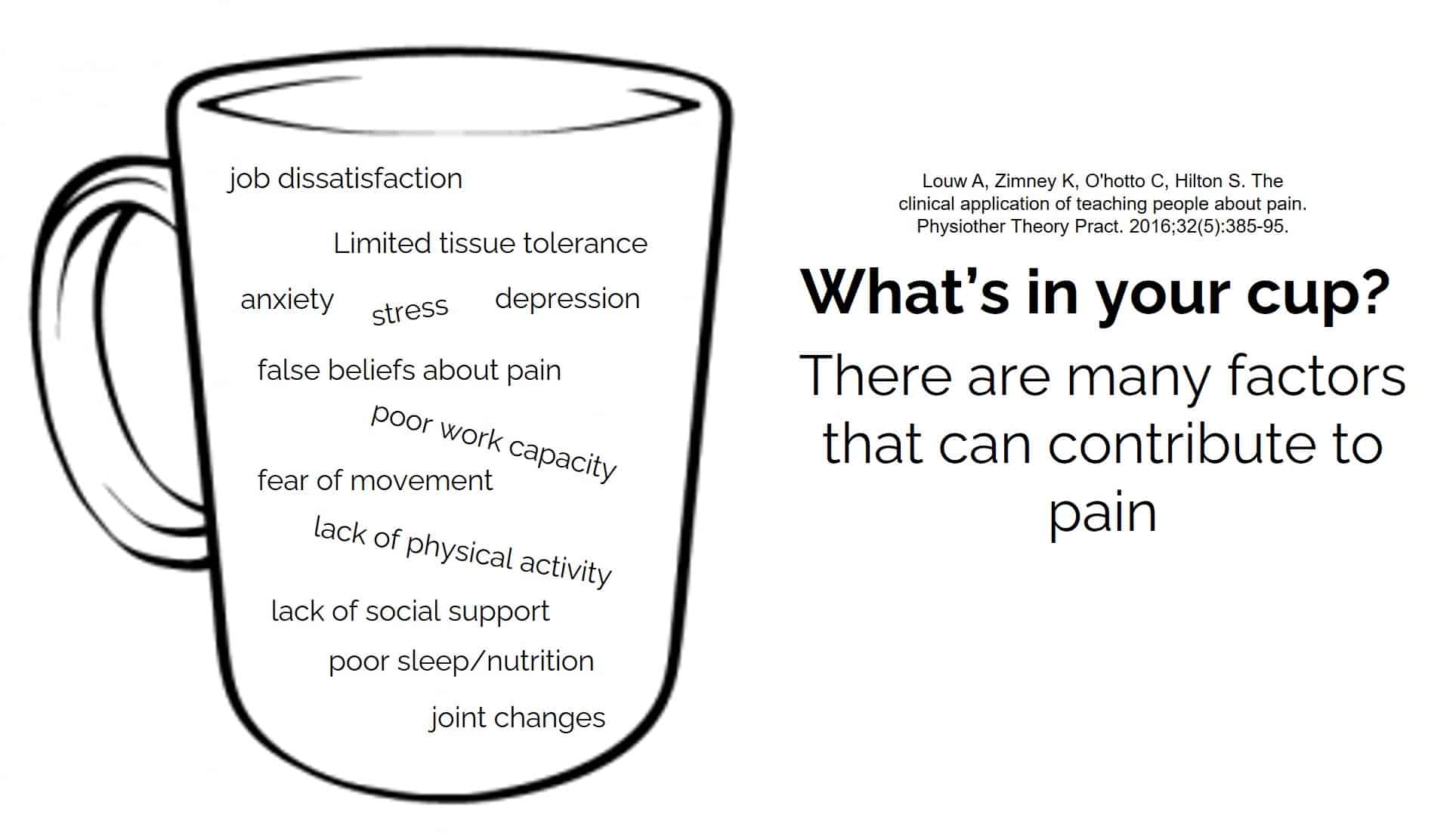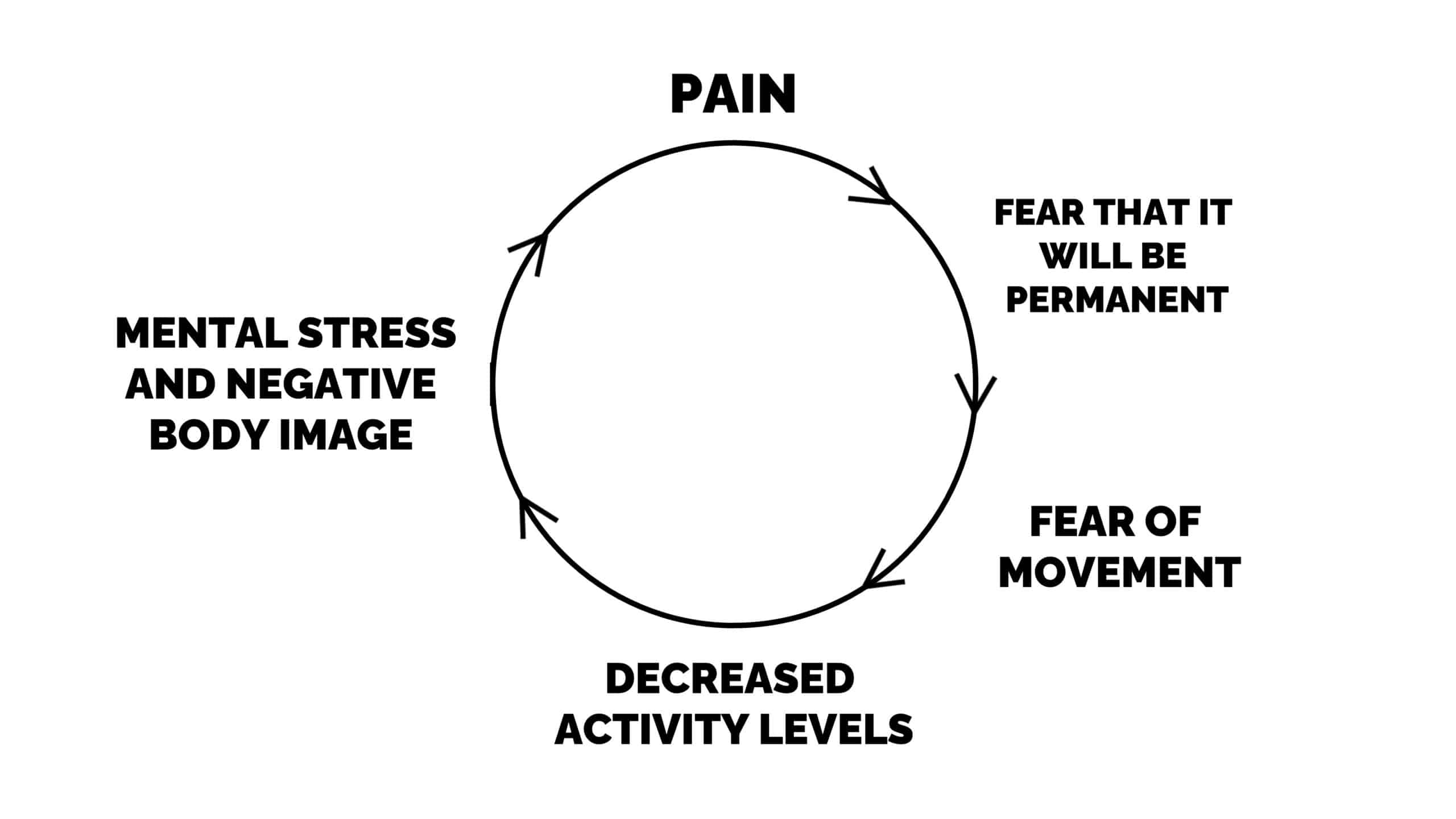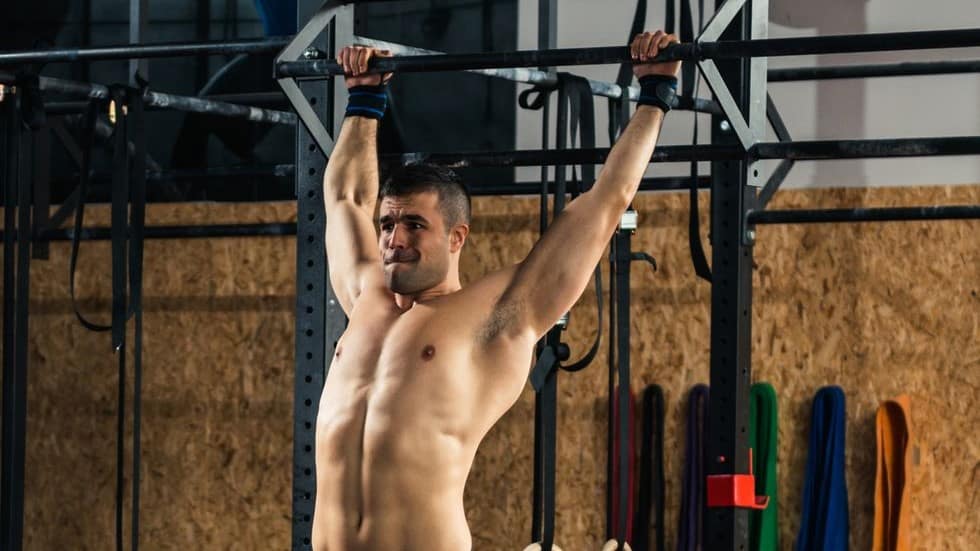When it comes to pain during barbell training, there are a lot of factors to consider. While fitness and healthcare professionals alike are often quick to jump to “bad form” as the culprit, unfortunately, it’s not that simple.
How Do We Define Pain?
According to the International Association for the Study of Pain (IASP), pain is defined as “An unpleasant sensory and emotional experience associated with actual or potential tissue damage, or described in terms of such damage.”
What does this definition really mean? I’d like to point out two factors. First, is the word “experience.” Pain is more than just having a body part that hurts. It involves the emotional experience associated with it. This may include fear that it might be permanent or the distress of missing out on social events or things you enjoy because of it.
Second, in the definition above, you’ll notice that it’s associated with “actual or potential damage.” This means that, yes, you can have pain without any physical tissue damage at all.
While this notion that pain doesn’t equal damage has gained popularity in the last 5 years, it still warrants repeating. Why? Because if pain doesn’t always equal damage, then it would also make little sense to say that it’s solely caused by bad form.
Now that we know that pain doesn’t always equal tissue damage, let’s talk about some of the various factors that can influence pain.
What Factors Can Influence Pain? The Coffee Cup Analogy
One of my favorite ways to explain pain is the coffee cup analogy. Think of a cup that is filled with coffee. The coffee inside the cup represents all of the different factors that can influence pain.
As seen below, these factors include stress, anxiety, depression, fear of movement, job dissatisfaction, joint changes, and much more. Now when all of these factors start to add up, you begin to have too much coffee. Too much coffee means your cup overflows and this is what we will call a pain experience.

So, as you can see, it is really a reductionist mentality to blame someone’s pain solely on “bad form” when we have ALL of these things that can contribute to it! So let’s talk more about these contributing factors.
The Big Three Psychosocial Factors: Stress, Anxiety, and Depression
Stress, anxiety, and depression are three psychosocial (psychological + sociological) factors that can really have an effect on someone’s pain experience. I’ve worked with many people that have had pain with training, and upon further examination, both their form and programming were solid…so what gives?
After digging a little further, I’d find that some sort of increase in their stress levels occurred right around the time the pain started. It may have been something as traumatic as a divorce or death in the family, or something else like moving, starting a new job, or having a baby.
Regardless, increases in life stress and inability to sufficiently cope with it can certainly influence the pain experience.
False Beliefs and Fear of Movement
False beliefs about pain itself can actually make pain worse and keep it lingering around for longer. Say what? Let me give you an example:
Let’s say that you deal with frequent bouts of low back pain from squatting. If you think that you have back pain because it “goes out of place” and that the only way your back will feel better is if you get it “put back in place” via a manipulation, then this can become a self-fulfilling prophecy.
In other words, if you have the false belief that your back goes out of place (it doesn’t by the way) and that you NEED a manipulation to feel better…you probably won’t feel better until you get a manipulation!
In this instance, learning that your back DOESN’T go out of place and that it is strong and stable, can help decrease the pain itself. It’s the mindset shift that kicks off this whole desensitization process.

If left unchecked, false beliefs about pain can lead to something called kinesiophobia or fear of movement. Continuing our example from before, if you have the false belief that your back CAN go out of place, this may cause you to move more gingerly through life in fear that it will go out of place.
This idea puts up a major barrier to movement, where, at best you may feel a little stiff and tight or at worst you become afraid to workout or train…just in fear that your back will go out of place.
Learning about pain can therefore help you overcome false beliefs and reduce fear of movement.
Job Dissatisfaction and Lack of Social Support
Job dissatisfaction and lack of social support can also contribute to someone’s pain experience. In fact, it’s been shown that dissatisfaction in one’s job is correlated to low back pain. Crazy right? This is another example of why it’s important to take a comprehensive history of your patients and clients to make sure you’re seeing the “complete picture.” Otherwise, you may end up assuming that a minor form deviation is the cause of pain and completely miss this.
When you’re in pain, it can often limit your social life. Maybe you can’t go to your weekly bowling match now because you tweaked your back on the deadlift. Or maybe you can’t train as hard as you’d like at the gym with your buddies because you’re hurt.
Regardless, when pain interferes with one’s ability to fully engage socially, this can lead to feelings of isolation and thus increased pain.
Don’t Throw the Baby Out With the Bathwater
Now we want to be careful not to swing the pendulum too far and just assume that increased psychosocial factors are always the cause of pain. They’re just one piece of the puzzle.
As you can see with our coffee cup analogy, physical factors like limited tissue tolerance, poor work capacity, lack of physical activity, and joint changes also influence the pain experience. I would also argue that you could put exercise form in this category, as form can really tie in with joint anatomy (more on this later).
The physical influences of pain are factors we already readily address. We KNOW that getting someone moving and increasing their aerobic capacity and tissue strength can help reduce pain. This is why we should be careful to avoid throwing the baby out with the bathwater. Pain has biopsychosocial influences. Don’t forget about that “bio” portion!
“Bad” Form and its Role in the Pain Experience
So now that you know that pain is a multifactorial experience, let’s talk about form. As mentioned, the relationship between exercise technique and pain most likely has to do with joint anatomy. Let’s use the example of hip pain and its correlation with squat stance:
If you take a highly retroverted individual and ask them to squat deep with load and a neutral spine, there’s a very good chance this may cause pain or a pinch in the front of the hip. Ask them to widen the stance a bit and turn their feet out and it will most likely completely eradicate the pain. This is a prime example of how joint anatomy combined with a specific exercise form can influence the pain experience.
I want to be clear though. There is nothing “bad” about a narrow stance toes forward squat, it just may not be the best option for someone with retroverted hips. Additionally, while the person in this example may also be dealing with life stressors, it’s highly unlikely that psychological stress is the main pain-driving factor here.
Programming and Pain: Rounded Back Deadlifts and Kipping Pull-Ups
Anytime the big “does form matter” argument arises, exercises such as the rounded back deadlift or kipping pull-up are usually mentioned. Why? Because of the notion that rounded back deadlifts are inherently “bad” for the spine and kipping pull-ups are “bad” for the shoulder.

Here’s the thing. Our body doesn’t even know what “form” is…all it realizes is that there’s a physical stressor being placed on it. It has no way to determine whether the form is “good” or “bad.” What it WILL tell you is that if the stress you’re applying to it is too much or applied too frequently…and that’s where programming comes into this equation.
One major talking point that we cover in the Barbell Rehab Workshop Online Course is the role of programming and pain. Take someone who has back pain with rounded back deadlifting. You can’t just assume that the form is the cause of this pain. The body is highly adaptable to the stressors you place on it, provided they are applied in an appropriate manner.
In most cases when someone has back pain with a rounded back deadlift, it has more to do with the DOSAGE and less to do with the form. Some common programming dosing errors I like to look for include:
- Are you doing too much volume in one day?
- Are you consistently training at an RPE of 9 or above?
- Are you trying to do a variation of a lift that requires more mobility than you currently have?
If you answer “yes” to any of the questions above, your pain may be more related to programming than form. To learn more about how to optimize programming, check out this article.
Overall, If you’re not used to doing a certain exercise, and then all of a sudden you start doing it at too high of an intensity, or with too much volume/frequency, this can lead to pain and injury.
We saw this happen in real time when COVID-19 hit in March. Gyms closed and many people stopped training for a few months. Then, when they re-opened a lot of people tried to jump right back into their prior programming only to get injured.
Here’s the truth. Rounded back deadlifts and kipping pull-ups aren’t inherently “bad,” but trying to do them at higher intensities and volumes after sitting on the couch for a month is probably not the best idea!
Some Techniques May be Easier to Adapt to than Others
Just so we are still on the same page, I’m not saying the form doesn’t matter at all…rather, it is just one aspect that might possibly affect the pain experience. In addition, some forms may be easier for the body to adapt to than others.
As mentioned above, while the body doesn’t really know what form is, it does recognize stress. And if you can get into a certain position or form that encourages the stress of the lift to be dispersed over more musculature, then it theoretically would be easier to adapt to.
One example of this that I like to use is setting the lats on the deadlifts. Many people struggle with the deadlift because they may only feel it right on their lumbar spine. When coached to consciously set the lats however, suddenly they feel the force dispersed across their entire back.
When it comes to the squat, bench press, and deadlift, for example, this is why we still teach form “optimization.” You wouldn’t bench press with the bar touching your face or squat with the barbell not centered on your back would you? There has to be some standard.
If you want to see detailed tutorial videos for the squat, bench press, deadlift, and overhead press, and how we like to program them, you can download our Beginner’s Guide to Barbell Training right here.
How to Comprehensively Address Pain with Barbell Training
Let’s continue with our coffee cup analogy for a minute. Now that you know that when you have “too much coffee in your cup” it can begin to overflow, and pain is experienced. So that essentially leaves us with two ways to reduce pain:
Strategy #1: Reduce the Contents of Your Cup
Reducing the contents of coffee in your cup may include self-management strategies to reduce stress, anxiety, and depression such as practicing mindfulness or meditation. If these strategies aren’t enough, or you’re struggling with this, you also may want to talk to your doctor about medication.
I’ve treated people with consistent or chronic pain who’ve seen improvement with antidepressant or anti-anxiety medication alone (although this is outside the scope of this article). I’m mentioning this just to show you that in these circumstances, it was never a “tissue issue”…it was due to psychosocial factors.
In fact, this is how education and just talking to someone can help reduce their pain…without ever doing one exercise. Teaching someone about pain and encouraging them to move and socially interact can, by itself, can reduce pain. This doesn’t mean that you shouldn’t exercise though. Which brings me to my next point.
Strategy #2: Build a Bigger Cup
While reducing the amount of coffee in your cup with stress management techniques is one way to reduce risk of recurrent pain experiences, you can also work on building a bigger cup. Building a bigger cup will help you become more resilient to stressors and essentially allow you to have more coffee. And how do you build a bigger cup? Strength training and aerobic work.
Improving tissue tolerance and work capacity through an optimally dosed strength and aerobic program will make you more resilient to life in general. You can’t go wrong with getting strong! This is why I’m a big proponent of addressing pain during barbell training with this two pronged approach.
Education alone or strength training alone isn’t the answer. It’s the combination of reducing the contents of your cup AND building a bigger cup that will give you the most bang for your buck.
“Bad” Form and Pain: Final Thoughts
There are so many variables to consider when someone has pain with training that it’s nearly impossible to blame “bad form” as the sole causative factor. That being said, it’s something you should still look at.
Due to different joint anatomical variations, some people respond better to some forms versus others. This doesn’t make one form “bad” and one form “good.” It just means that some form variations aren’t optimal for certain individuals.
Pain is a multifactorial experiencing consisting of biological, psychological, and sociological factors. While at first glance this may look daunting, I encourage you to look at this as a good thing. Since there’s so many different factors that can contribute to pain, this gives you many different routes for how to overcome it!
Reduce the contents of your cup with stress management techniques, mindfulness, and doing the things you enjoy, and build a bigger cup with strength training and aerobic work. Stop blaming bad form alone for pain!

